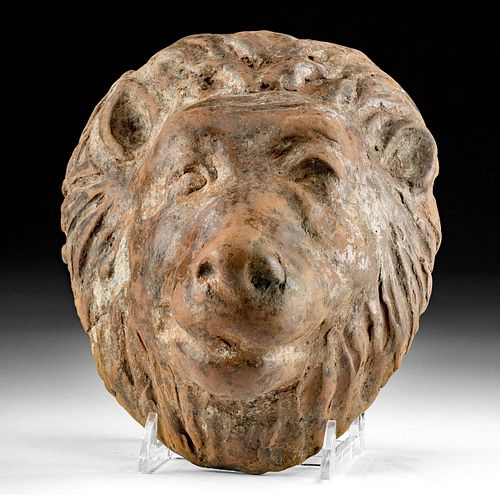Imposing Greek Hellenistic Pottery Protome Lion Head
Lot 53
About Seller
Artemis Gallery
686 S Taylor Ave, Ste 106
Louisville, CO 80027
United States
Selling antiquities, ancient and ethnographic art online since 1993, Artemis Gallery specializes in Classical Antiquities (Egyptian, Greek, Roman, Near Eastern), Asian, Pre-Columbian, African / Tribal / Oceanographic art. Our extensive inventory includes pottery, stone, metal, wood, glass and textil...Read more
Categories
Estimate:
$1,600 - $2,400
Absentee vs Live bid
Two ways to bid:
- Leave a max absentee bid and the platform will bid on your behalf up to your maximum bid during the live auction.
- Bid live during the auction and your bids will be submitted real-time to the auctioneer.
Bid Increments
| Price | Bid Increment |
|---|---|
| $0 | $25 |
| $300 | $50 |
| $1,000 | $100 |
| $2,000 | $250 |
| $5,000 | $500 |
| $10,000 | $1,000 |
| $20,000 | $2,500 |
| $50,000 | $5,000 |
| $100,000 | $10,000 |
| $200,000 | $20,000 |
About Auction
By Artemis Gallery
Jun 10, 2021
Set Reminder
2021-06-10 10:00:00
2021-06-10 10:00:00
America/New_York
Bidsquare
Bidsquare : Exceptional Antiquities | Asian | Ethnographic
https://www.bidsquare.com/auctions/artemis-gallery/exceptional-antiquities-asian-ethnographic-7012
Museum-worthy examples of Egyptian, Greek, Roman, Viking, Near Eastern, Far East / Asian, Pre-Columbian, African / Tribal, Oceanic, Native American, Spanish Colonial, Russian, Fossils, Ancient Jewelry, Fine Art, so much more! Artemis Gallery info@artemisgallery.com
Museum-worthy examples of Egyptian, Greek, Roman, Viking, Near Eastern, Far East / Asian, Pre-Columbian, African / Tribal, Oceanic, Native American, Spanish Colonial, Russian, Fossils, Ancient Jewelry, Fine Art, so much more! Artemis Gallery info@artemisgallery.com
- Lot Description
Greece, Hellenistic Period, ca. 3rd to 2nd century BCE. A fine mold-made pottery protome depicting a majestic lion head. The protruding leonine countenance presents with sunken eyes bearing a furrowed brow above the extended snout and flared nostrils. The face is framed by a series of thick, curving locks from the mane, and two perked ears protrude from the top. The verso reveals the concave interior with thick walls. The exterior is a buff-brown hue. This protome may have been a handsome addition to an architectural element. Size: 5.575" L x 3.75" W x 7" H (14.2 cm x 9.5 cm x 17.8 cm)
In the classical world, lions symbolized power, wealth, and might. They were famously featured in many ancient myths, perhaps the most famous being that of Hercules (Greek Herakles) slaying the Nemean lion for his first labor. That lion's fur was believed to be impenetrable to attacks since according to legend it was made of gold and its claws were far sharper than swords with the power to slice through armor. In the end, Hercules defeated the lion by strangling it and wore its skin. Lions were also favorite iconography for buildings, coins, and statues in the ancient world. Examples include the Lion Gate to the Citadel of Mycenae, the Terrace of the Lions on the island of Delos, and the lion hunt mosaic from Pella featuring Alexander engaged in a lion hunt.
Provenance: private New York, USA collection; ex-Robert Feuer collection, Long Island, New York, USA, acquired in Tarshish, Jerusalem, Israel in the 1980s
All items legal to buy/sell under U.S. Statute covering cultural patrimony Code 2600, CHAPTER 14, and are guaranteed to be as described or your money back.
A Certificate of Authenticity will accompany all winning bids.
We ship worldwide and handle all shipping in-house for your convenience.
#164993Stable fissures on interior and peripheries. Surface abrasions and nicks. Mineral, earthen, and calcified encrustations. Nice preservation of details.Condition
- Shipping Info
-
All shipping is handled in-house for your convenience. Your invoice from Artemis Gallery will include shipping calculation instructions. If in doubt, please inquire BEFORE bidding for estimated shipping costs for individual items.
-
- Buyer's Premium



 EUR
EUR CAD
CAD AUD
AUD GBP
GBP MXN
MXN HKD
HKD CNY
CNY MYR
MYR SEK
SEK SGD
SGD CHF
CHF THB
THB














